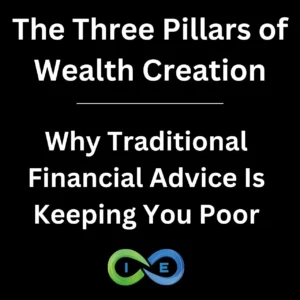In the following article covering the basics on how whole life insurance works we will explore the mechanics involved in the policy, compare and contrast it with other types of life insurance coverage, such as term life and universal life, as well as provide additional information on the different whole life product offerings available in our effort to answer the question,”how does whole life insurance work.”
How Whole Life Insurance Works
Whole life insurance combines a death benefit guaranteed throughout the entire life of the insured (as long as premiums are paid, and the policy is not surrendered) with a savings component allowing the policy to accrue a cash value that steadily increases the longer the policy remains in place.
The big advantages of whole life vs term life are that the premiums remain level no matter how old you get, the policy remains in place for life with a consistent death benefit, and the cash value allows you to realize an actual financial benefit during life.
In similar fashion, whole life vs universal life pits the guarantees of whole life, guaranteed fixed premiums, guaranteed cash value and guaranteed death benefit, juxtaposed with universal life insurance where the premiums and death benefit are flexible, but not guaranteed.
Rate of Return
It should be noted that whole life insurance is not an investment as much as it is a low risk savings vehicle. And despite misguided opinions, most whole life policies provide adequate returns. The internal rate of return on whole life policies can be higher or lower based on how the policy is designed.
In fact, a MassMutual dividend study found that the actual internal rate of return on a 10-Pay policy for a 50 year old came in at 6.01%. (1) And a 6% return is much higher when you consider that the return may never be taxed if you choose to utilize the cash value via life insurance loans.
When assessing whole life insurance pros and cons, typically the main negative focused on is that premium payments are substantially higher than term life for younger insureds. What is often overlooked though is the premiums for renewed term life policies increase dramatically as you age and eventually exceed whole life premiums for a policy purchased early in life.
Whole life is also referred to as “traditional life insurance” because it was the most popular life insurance product during the first three-quarters of the twentieth century. It’s attractive for people relatively early in their careers because it allows you, with a single policy, to provide for your family in the event of your untimely death while also creating a life insurance retirement plan through the policy’s accrued cash value.
When most people think of life insurance, they think of what is known as “term life.” Under a term life policy, the insured pays regular premiums to the life insurance company for an agreed number of years (the “term”), and, if the insured dies during the term of the policy, the insurer pays out a lump sum death benefit to the beneficiary. It’s a fairly simple, straightforward concept, but it has an obvious drawback: if you don’t die during the term, neither you nor your beneficiaries receive anything from the policy. You made all the premium payments but have nothing to show for it.
If you’re only concerned about ensuring that your family will be financially secure if you die during the policy term, then term life might be all you need. However, if you want to hedge your bets and have something to show for all those premium payments if you don’t die right away, whole life might be a better option.
BTID
Since the 1970’s, thanks to the mantra “buy term and invest the difference“, AKA “BTID”, more people have opted to purchase cheaper term life policies during their working years and save for retirement in separate retirement accounts.
Coincidentally, the term “BTID” was coined by a term life insurance salesman and picked up by the financial community, as it drove people with whole life insurance to replace their policy and buy term, sticking the difference in premium into the hands of Wall Street (and we wonder why many elderly are retiring with very little retirement savings).
Whole Life Insurance Rates
Whole life insurance rates are determined at the time the policy is approved and are locked-in at the same rate for the policyholder’s entire life.
The amount paid by the insured depends upon a host of factors, including the amount of coverage, the insured’s age at the time of purchase, the type of life insurance policy and the insured’s health.
| Age | $100,000 | $250,000 | $500,000 | $1,000,000 |
|---|---|---|---|---|
| 20 | $83 | $151 | $293 | $580 |
| 25 | $92 | $178 | $348 | $689 |
| 30 | $105 | $216 | $422 | $839 |
| 35 | $121 | $267 | $522 | $1038 |
| 40 | $141 | $326 | $639 | $1273 |
| 45 | $173 | $401 | $789 | $1571 |
| 50 | $214 | $499 | $982 | $1959 |
| 55 | $270 | $629 | $1239 | $2473 |
| 60 | $324 | $802 | $1582 | $3158 |
The above sample whole life insurance quotes are from A rated carriers and higher. Rates are subject to approval and must be qualified for.
Types of Whole Life Insurance Policies
Many whole life policies sold today are considered guaranteed issue. A “guaranteed issue” policy is issued without any medical examination or health questions at the time of application. Often, life insurance for seniors will be of this variety, although it may be in their best interest to try and find a better policy, if available.
“Simplified issue” policies require a medical questionnaire but no exam. Some no exam life insurance companies require more extensive automated accelerated underwriting, which still covers the full range of testing required for fully underwritten policies, minus the life insurance blood testing.
“Fully underwritten” policies require a detailed medical evaluation including a full life insurance medical exam by a healthcare professional. Generally, fully underwritten policies have lower premiums, especially for relatively young and healthy insureds, because the insurance company can more accurately gauge the level of risk it is undertaking.
Some insurance providers offer variations on the standard, level premiums required with most whole life policies. A limited pay life insurance policy option requires higher premiums during a defined period but is considered “paid up,” remaining effective but with no further premiums owed, at the end of the agreed term.
A limited payment policy can be a good choice for individuals who can afford the higher premiums during their productive years but want to limit expenses upon retirement.
If premiums are paid on a whole life policy long enough (age 100 on older whole life policies; 121 on newer issued policies), its cash value eventually equals the amount of the death benefit (the “face value” of the policy). At this point, a policy is considered “mature,” and the life insurance company can simply cut the policyholder a check for the entire policy’s face amount.
Cost of Insurance (COI)
Once a policy issues, the policyholder pays regular premium payments to the insurer as long as the policy remains in force. The total insurance premium is apportioned toward the policy’s cash value and the cost to the insurer for providing the death benefit.
With some permanent life insurance policies, a higher percentage goes toward the cash value initially because the life insurance company’s underwriting cost is relatively low. As time passes, the percentage applied to the cost of insurance increases, and the cash-value portion decreases, as the likelihood of death goes up.
In contrast, whole life insurance premiums include the cost of insurance for the entire life of the policy. That way, the owner of the policy will pay a fixed premium throughout, regardless of what the stock market or interest rate returns are.
How does whole life insurance cash value work?
With each premium payment, the policy’s cash value increases due to both the continuing payments and the growth earned. The part of the premium applied to the cash value is put into an account with the insurance company and invested. The insurer guarantees the rate of growth on whole life policies, so the company bears the risk of poor investment performance.
Variable life insurance policies are similar to whole life except that returns are based upon investment performance and so can sometimes outpace whole life returns in strong markets. However, return rates are not guaranteed for variable life policies and, if markets are weak, returns can even be negative.
You can use the cash value as collateral or take borrow against the life insurance policy itself – typically at a rate lower than standard bank loan rates. Loans are income tax free and you can use the money for anything you choose.
One of the reasons life insurance is a great asset is because loan repayment requirements are lenient, allowing you to set the terms of repayment or you can choose to not repay the loan at all. And if a loan is not paid back, the amount outstanding is simply deducted from the death benefit when you die.
If sufficient cash value has accumulated, you can also make a withdrawal directly from the cash value. However – like unpaid loans – withdrawals reduce the available death benefit, depending upon the size of the withdrawal.
Cash Surrender Value
A policy’s cash value is also referred to as “cash surrender value” or just “surrender value” because, effectively, it refers to the amount of the check the life insurance company will send you if you choose to surrender the policy.
When a policy is “surrendered,” you’re telling the insurer that you no longer want or need the death benefit.
So, maybe the kids are all grown up and self-sufficient, you’re retired, and so the financial impact your death would have on your loved ones is no longer much of a concern.
And, since you no longer need life insurance and want to keep expenses down in retirement, you may decide to surrender the policy. Of course, this means there will no longer be any death benefit for your heirs. However, in this scenario, having the cash now as an additional means of funding your retirement may very well make more sense than increasing the size of your eventual estate.
The ability to surrender a policy you no longer need and still realize some return on all those years of premium payments is a big part of what separates whole life from term life. But it’s worth noting that taking the cash is not your only option when surrendering a policy.
Alternatives to Cash Surrender
Alternatively, some insurers will allow you to convert cash value into extended term coverage – essentially pre-paying the premiums on a long-term term life policy – or you may be able to roll over your surrendered whole life policy into an annuity contract, which might have the potential for higher returns. Finally, life settlements are also available, which allow you to sell your insurance policy for usually more than the cash surrender value.
Whole Life Insurance Dividends
Life insurance dividends are annual payments made by the insurance company to policyholders based upon the company’s overall performance. Importantly, dividends are not guaranteed, and not all whole life policies pay dividends.
A non-participating life insurance policy is a policy in which the insured opts to not be eligible for dividends in exchange for lower insurance premiums. In contrast, participating whole life insurance provides an annual dividend payment to policyholders.
Whether a dividend-paying policy is worth the extra insurance premiums depends upon how consistent the company is in paying dividends and the amounts paid when dividends are earned. And many of the top mutual insurance companies have consistently paid dividends each and every year for the last 100+ years.
5 Options
If your whole life policy is participating, i.e. it receives a dividend, you have essentially five options. You can take the dividend in cash, you can apply it toward your premiums to reduce future payments, you can deposit it in an interest-bearing account with the insurer, you can pay back a policy loan, or you can use it to purchase additional paid-up insurance coverage on your policy. In the latter case, the dividend increases the death benefits and cash value of the policy without a corresponding increase in premiums.
How is whole life useful in estate and retirement planning?
The advantage to whole life is in its flexibility – you get a guaranteed death benefit for your estate that can also serve as a source of retirement funding if you don’t end up needing the death benefit. And retirees can use the cash value in a variety of ways.
The first and most straightforward is to surrender the policy and take the cash. But, again, then you no longer have a death benefit.
Some policyholders opt to let the cash value build up during working years and then use the cash value and dividends as income in retirement by borrowing against the cash value via policy loans.
For some policyholders, the guaranteed death benefit is the primary attraction of whole life. Whereas term life premiums can increase to the point of becoming unaffordable as the policyholder ages, whole life premiums stay steady – allowing for better predictability in retirement and estate planning.
The death benefit can be used as a source of liquidity for otherwise non-liquid estates – providing an executor with funds to pay estate taxes, administration fees, real estate taxes and upkeep costs, and funeral costs. Or, if you need to provide for a dependent, the death benefit can be used to ensure adequate cash is available to fund a special needs trust.
What is the tax treatment for whole life insurance?
Whole life policies generally receive favorable tax treatment. Increases in the policy’s cash value are usually not taxable as income. And, because dividends are considered “return on premium,” they are usually not taxable income either.
Life insurance is not taxable, although the death benefit may be subject to estate taxes, depending upon the total value of the estate and who receives the payout. If the beneficiary is a third-party, the lump-sum payout is not included in the estate. If the payee is the estate itself, the funds will be subject to estate taxes if the estate is large enough – though recent increases in the exemption amount keep all but the largest estates from qualifying for the death tax.
If you opt to surrender the policy, or to make withdrawals, the cash received is tax-free up to the basis in the contract, which is the amount of premiums paid up to that point. Thus, if the surrender value or amount withdrawn is less than the total premiums paid, it won’t qualify as taxable income. If the amount received is greater than the amount of premiums paid, the overage minus the amount of any dividends (remember, those are non-taxable “return on premium”) will be taxable income.
Conclusion
Whole life insurance provides a solid internal rate of return that can be further maximized through the use of life insurance loans. In addition, life insurance has many other benefits not discussed in this article, such as creditor protection and privacy.
Please check out our resources page for more information, as well as follow the links provided in this article. If you have any questions or comments, please leave your remarks in the comments section below.





